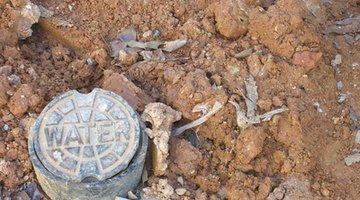How to Equalize Water Pressure for In Home Plumbing
One amenity to consider for any house is its water supply and ensuring it comes into the home with consistent water pressure. The shower should provide the same amount of pressure whether water is in use at the kitchen sink or not.

Things You Will Need
- Pressure gauge
- Strap wrench
- Teflon tape
- Slotted screwdriver
A valve installed on the pipe that supplies water to a building, stabilizes water pressure throughout the home to keep the pressure to the desired level. This valve also keeps water pressure from rising to a dangerous level, which could harm the plumbing.
-
Contact your local or county building administration office to ask about local and state codes regarding the addition of a pressure regulator valve. You may be required to purchase a building permit, or have the installation inspected in some localities. Certain states have stringent regulations for such plumbing operations while others have none. Contact the utility company that supplies your water to enquire of any considerations they may have for installing pressure reducer valves.
-
Open the cover to your meter housing and take note of the pipe size and material. The meter is usually contained within a small metal box buried in the ground close to the street. Purchase a pressure reducing valve with the proper size fittings that are metal for metal pipes or plastic for plastic pipes.
-
Turn off the water heater by shutting off the breaker switch for an electric unit, or by turning the gas flow dial to the "Pilot" setting on a gas water heater. Shut off the water supply to the house with the valve in the meter box. Bleed off all water pressure by turning on the water at every hose bib sink and tub faucet.
-
Wrap Teflon tape around the exposed threads for the pressure regulator installation. Twist the valve onto the pipe threads with the direction arrow pointing away from the meter and toward the house. Tighten the joint firmly by turning the sleeve nut with a strap wrench 1/4 rotation.
-
Place Teflon tape around the threads between the water pressure reducer and the pressure gauge. Twist the gauge on with the flow direction running from the meter to the house and tighten with a strap wrench. Connect the water supply pipe for the house to the other side of the gauge.
-
Close all the valves in the house and turn on the water at the meter. Turn the water heater back on. Turn the water supply back on at the meter. Check the pressure at the pressure gauge. Turn the pressure set screw on the valve with a slotted screwdriver to get the reading on the gauge at a consistent water pressure between 50 and 70 pounds per square inch (psi). Test the pressure with regular water use and adjust to your preferred setting.
Warning
Do not set the pressure over 70 psi as home plumbing pipes and joints are damaged by excessive pressure. Consult or hire a certified plumber for any work you are not trained or experienced to perform. A plumber's pressure regulator installation fee will cost less than replacing damaged pipes.
References
Warnings
- Do not set the pressure over 70 psi as home plumbing pipes and joints are damaged by excessive pressure. Consult or hire a certified plumber for any work you are not trained or experienced to perform. A plumber's pressure regulator installation fee will cost less than replacing damaged pipes.
Writer Bio
Jonra Springs began writing in 1989. He writes fiction for children and adults and draws on experiences in education, insurance, construction, aviation mechanics and entertainment to create content for various websites. Springs studied liberal arts and computer science at the College of Charleston and Trident Technical College.
Photo Credits
- water meter image by jimcox40 from Fotolia.com
- water meter image by jimcox40 from Fotolia.com
More Articles
- Gas Range Installation Requirements
- How to Adjust the Pressure in a Lawn Genie L7034 Anti-Siphon Irrigation Valve
- The Proper Tubing Size for a 30,000 BTU Natural Gas Heater
- How to Lower the PSI Pressure on a Weil McLain Boiler
- How to Locate an Underground Water Pressure Regulator
- How to Dewinterize a Foreclosed House



